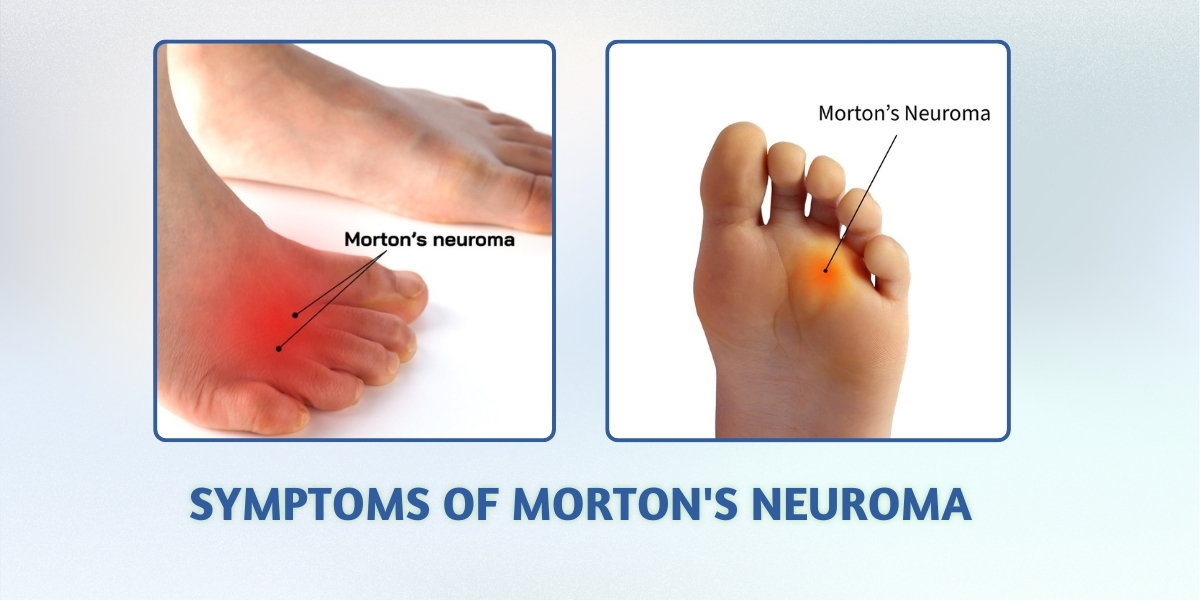Morton’s Neuroma is a painful condition that affects the ball of your foot, particularly the area between your third and fourth toes. It occurs when the tissue surrounding one of the nerves leading to your toes thickens, which can cause severe discomfort and pain. The condition is common among runners, athletes, and individuals who regularly wear tight or high-heeled shoes. Understanding the symptoms of Morton’s Neuroma is crucial for early diagnosis and treatment, helping to prevent further complications.
What is Morton’s Neuroma?
Morton’s Neuroma, also known as intermetatarsal neuroma, is a benign (non-cancerous) growth of nerve tissue. This condition leads to a sharp or burning pain in the ball of the foot, typically exacerbated by physical activity or wearing improper footwear. People with Morton’s Neuroma often describe it as feeling like they are standing on a pebble inside their shoe or having a fold in their sock that won’t go away. While it is not a visible condition, the nerve inflammation can become so severe that it disrupts daily activities.
Common Symptoms of Morton’s Neuroma
The symptoms of Morton’s Neuroma can vary, but they generally include:
1. Pain in the Ball of the Foot
The most common symptom of Morton’s Neuroma is a sharp, burning pain in the ball of the foot. The pain typically intensifies with walking, standing, or wearing shoes that compress the foot, such as tight, narrow shoes or high heels. This pain can be persistent or come and go, depending on the severity of the neuroma.
2. Numbness and Tingling in the Toes
As the nerve becomes irritated, people with Morton’s Neuroma may experience numbness and tingling in the toes. This symptom is often described as a “pins and needles” sensation and can affect one or more toes, especially the third and fourth. This numbness can be constant or intermittent.
3. A Lump or Swelling Between the Toes
Although Morton’s Neuroma is not a visible condition, some individuals may feel a lump or swelling in the area between their toes. This sensation can be particularly noticeable when walking or standing for long periods and may worsen over time as the nerve thickens.
4. The Feeling of a Pebble in the Shoe
One of the most characteristic symptoms of Morton’s Neuroma is the feeling of having a small pebble or foreign object lodged under the ball of the foot. This sensation can be incredibly uncomfortable and is a common complaint among those with the condition.
5. Pain that Radiates to Other Areas
While the pain is typically localized to the ball of the foot, it can sometimes radiate to other parts of the foot, such as the toes, or even up into the leg. This radiating pain may be sharp and sudden, or it may develop gradually over time.
6. Increased Discomfort with Physical Activity
Morton’s Neuroma often becomes more noticeable during or after physical activity, particularly activities that place pressure on the ball of the foot, such as running, walking, or playing sports. This increase in discomfort can make it difficult for individuals to engage in activities they once enjoyed.
What Causes Morton’s Neuroma?
Several factors can contribute to the development of Morton’s Neuroma, including:
- Footwear Choices: Wearing high heels or shoes that are too tight can compress the nerves in the foot, leading to inflammation and the development of a neuroma.
- Foot Deformities: Conditions such as bunions, hammertoes, or flat feet can cause abnormal pressure on the nerves in the foot, increasing the likelihood of developing Morton’s Neuroma.
- Repetitive Stress: Activities that involve repetitive motions or prolonged pressure on the ball of the foot, such as running or ballet dancing, can lead to the development of the condition.
- Injury: Trauma to the foot can cause nerve damage, leading to the formation of a neuroma.
Diagnosis of Morton’s Neuroma
Diagnosing Morton’s Neuroma typically involves a combination of physical examination and imaging tests. During a physical exam, a doctor will apply pressure to the affected area to assess the level of pain and discomfort. They may also ask you to perform certain movements to evaluate how the condition is affecting your mobility. In some cases, an ultrasound or MRI may be recommended to confirm the diagnosis and rule out other potential causes of foot pain, such as stress fractures or arthritis.
Treatment Options for Morton’s Neuroma
The goal of treatment for Morton’s Neuroma is to reduce pain and prevent further damage to the nerve. Treatment options vary depending on the severity of the condition and may include:
1. Changing Footwear
One of the most effective ways to alleviate the symptoms of Morton’s Neuroma is to switch to more comfortable footwear. Shoes with a wide toe box, low heels, and good arch support can reduce pressure on the nerve and provide relief.
2. Orthotic Devices
Custom orthotics or shoe inserts can help to redistribute pressure on the foot and reduce strain on the affected nerve. These devices are particularly helpful for individuals with foot deformities or those who engage in activities that place stress on the ball of the foot.
3. Physical Therapy
Physical therapy exercises can strengthen the muscles in the foot and improve flexibility, which can help to alleviate the symptoms of Morton’s Neuroma. Stretching and massage techniques can also relieve tension in the foot and promote healing.
4. Medications
Over-the-counter pain relievers, such as ibuprofen or acetaminophen, can help to reduce pain and inflammation associated with Morton’s Neuroma. In more severe cases, a doctor may recommend corticosteroid injections to provide longer-lasting relief.
5. Surgery
If conservative treatments do not provide relief, surgical intervention may be necessary. Surgery for Morton’s Neuroma typically involves removing the affected nerve or releasing the tissue that is compressing the nerve. While surgery is generally effective, it does carry the risk of complications, such as infection or permanent numbness in the toes.
Preventing Morton’s Neuroma
To prevent the development of Morton’s Neuroma, it is important to take proactive measures, such as:
- Wearing Proper Footwear: Choose shoes that provide adequate support and avoid high heels or shoes with narrow toe boxes.
- Maintaining a Healthy Weight: Excess weight can place additional pressure on the feet, increasing the risk of developing foot conditions like Morton’s Neuroma.
- Stretching and Strengthening Exercises: Regular stretching and strengthening exercises can help to improve foot mechanics and reduce the likelihood of developing a neuroma.
- Avoiding High-Impact Activities: Limit activities that place excessive stress on the feet, particularly if you are prone to foot pain or have a history of neuromas.
Morton’s Neuroma is a manageable condition with proper treatment and preventive measures. If you experience any of the symptoms described above, it is essential to seek medical advice for early diagnosis and treatment. Meet Dr. Chetan Oswal at Orthowin Speciality Clinic for the best treatment of Foot And Ankle Related Problems.





